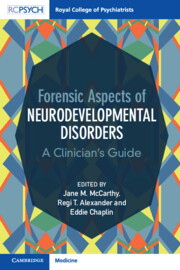Book contents
- Forensic Aspects of Neurodevelopmental Disorders
- Forensic Aspects of Neurodevelopmental Disorders
- Copyright page
- About the Cover Page
- Contents
- Contributors
- Foreword by the Rt Hon Lord Bradley
- Terminology Used in the Book
- Section 1 An Overview: Definitions, Epidemiology and Policy Issues
- Chapter 1 Introduction
- Chapter 2 Aetiology of Neurodevelopmental Disorders
- Chapter 3 Overview of Offenders with Intellectual Disability
- Chapter 4 Overview of Offenders with Attention Deficit Hyperactivity Disorder
- Chapter 5 Overview of Offenders with Autism Spectrum Disorder
- Chapter 6 Associations between Autism Spectrum Disorder and Types of Offences
- Chapter 7 Overview of Young People with Neurodevelopmental Impairments in Contact with the Youth Justice System
- Chapter 8 Overview of Offenders with Fetal Alcohol Spectrum Disorders
- Chapter 9 The Role of Subthreshold Neurodevelopmental Disorder in Offending Behaviour
- Chapter 10 Comorbid Mental Disorders and Neurodevelopmental Conditions
- Section 2 Assessment and Therapeutic Approach
- Section 3 Criminal Justice Pathways and Legal Issues
- Index
- References
Chapter 9 - The Role of Subthreshold Neurodevelopmental Disorder in Offending Behaviour
from Section 1 - An Overview: Definitions, Epidemiology and Policy Issues
Published online by Cambridge University Press: 18 May 2023
- Forensic Aspects of Neurodevelopmental Disorders
- Forensic Aspects of Neurodevelopmental Disorders
- Copyright page
- About the Cover Page
- Contents
- Contributors
- Foreword by the Rt Hon Lord Bradley
- Terminology Used in the Book
- Section 1 An Overview: Definitions, Epidemiology and Policy Issues
- Chapter 1 Introduction
- Chapter 2 Aetiology of Neurodevelopmental Disorders
- Chapter 3 Overview of Offenders with Intellectual Disability
- Chapter 4 Overview of Offenders with Attention Deficit Hyperactivity Disorder
- Chapter 5 Overview of Offenders with Autism Spectrum Disorder
- Chapter 6 Associations between Autism Spectrum Disorder and Types of Offences
- Chapter 7 Overview of Young People with Neurodevelopmental Impairments in Contact with the Youth Justice System
- Chapter 8 Overview of Offenders with Fetal Alcohol Spectrum Disorders
- Chapter 9 The Role of Subthreshold Neurodevelopmental Disorder in Offending Behaviour
- Chapter 10 Comorbid Mental Disorders and Neurodevelopmental Conditions
- Section 2 Assessment and Therapeutic Approach
- Section 3 Criminal Justice Pathways and Legal Issues
- Index
- References
Summary
The study of subthreshold neurodevelopmental disorders (STNDs) and the implications for future health, social and criminal justice services is in its infancy. Current research points towards increased vulnerability to a number of risk factors that are likely to impact both the individual and future service demand. Offenders who meet diagnostic criteria for a specific neurodevelopmental disorder are often shown to have more similarities than differences to offenders with STNDs. As well as communication and adaptive problems, similarities also include higher rates of mental disorder and increased vulnerability to suicide and self-harm. Within STNDs there exists a wide variation in presentation which may be atypical. The future study of STNDs requires a coordinated strategy and agreement as to a common definition using a dimensional approach.
Keywords
- Type
- Chapter
- Information
- Forensic Aspects of Neurodevelopmental DisordersA Clinician's Guide, pp. 101 - 111Publisher: Cambridge University PressPrint publication year: 2023



